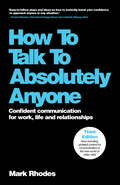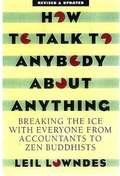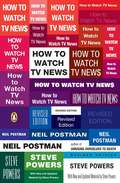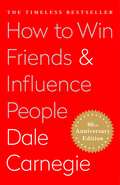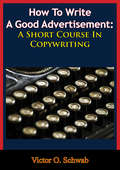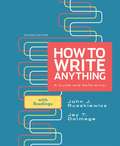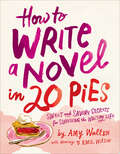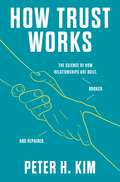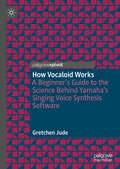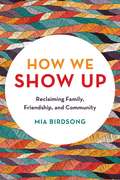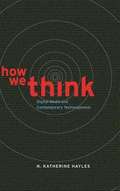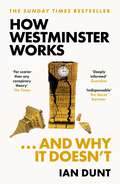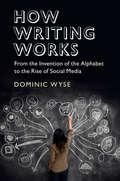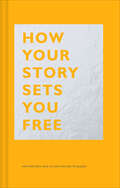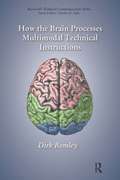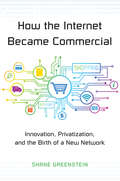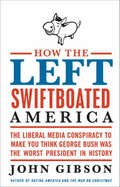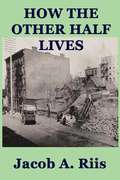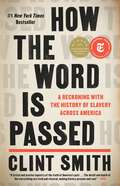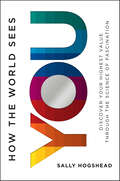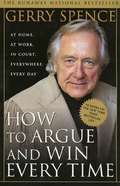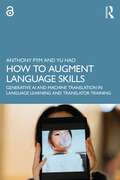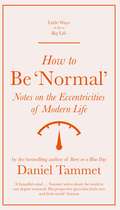- Table View
- List View
How To Talk To Absolutely Anyone: Confident Communication for Work, Life and Relationships
by Mark RhodesAn easy-to-understand, practical guide to become a confident communicator In this third edition of How to Talk to Absolutely Anyone: Confident Communications in Every Situation, entrepreneur, business mentor, and international speaker Mark Rhodes delivers a practical yet accessible guide to break through barriers and make a connection. Whether you fear judgement and rejection, or just struggle to know what to say, this book provides readers with the tools needed to navigate social situations. Working step-by-step, you'll learn how to approach strangers, strike up a conversation and exit gracefully; by first changing your outlook, you develop the ability to navigate even tricky situations with confidence and ease. Drawing on Mark Rhodes' extensive business and coaching experience, this new third edition has been updated to include information on technology and communication to reflect the ever-growing use of remote communication. This book provides real-world techniques to help you get better and better every day, enabling you to: Strike up a conversation with anyone, anywhere. Open up to make connections and build strong rapport. Overcome common fears and barriers about talking to others. Carry your confidence into career networking and everyday communication. Stop running away from uncomfortable interactions and start getting comfortable instead. How to Talk to Absolutely Anyone is your social manual to help you build up the charismatic confidence and skills needed to talk your way to success.
How To Talk To Anybody About Anything: Breaking The Ice With Everyone From Accountants To Zen Buddhists (Third Edition)
by Leil LowndesLeil Lowndes has a special knack for breaking the ice. In How to Talk to Anybody About Anything, she details the most appropriate, provocative, and specific questions to ask in order to communicate effectively. Alphabetized by subject, this newly updated version contains tips on how to talk to more than 200 types of people, based on their careers, occupations, hobbies, and other interests.
How To Watch TV News
by Neil Postman Steve PowersA scathing and prescient look at television news,now updated for the new tech-savvy generation Television news : genuine information or entertainment fodder? Fifteen years ago, Neil Postman, a pioneer in media education and author of the bestselling Amusing Ourselves to Death, and Steve Powers, an award-winning broadcast journalist, concluded that anyone who relies exclusively on their television for accurate world news is making a big mistake. A cash cow laden with money from advertisers, so-called news shows glut viewers with celebrity coverage at the cost of things they really should know. Today, this message is still appallingly true but the problems have multiplied? along with the power of the Internet and the abundance of cable channels. A must-read for anyone concerned with the way media is manipulating our worldview, this newly revised edition addresses the evolving technology and devolving quality of America?s television news programming.
How To Win Friends and Influence People: Large Print Edition (Deluxe Hardbound Edition Ser.)
by Dale CarnegieYOU CAN GO AFTER THE JOB YOU WANT...AND GET IT! YOU CAN TAKE THE JOB YOU HAVE...AND IMPROVE IT! YOU CAN TAKE ANY SITUATION YOU'RE IN...AND MAKE IT WORK FOR YOU! For more than sixty years the rock-solid, time-tested advice in this book has carried thousands of now famous people up the ladder of success in their business and personal lives. Now this previously revised and updated bestseller is available as eBook for the first time to help you achieve your maximum potential throughout the next century! Learn: * THREE FUNDAMENTAL TECHNIQUES IN HANDLING PEOPLE* THE SIX WAYS TO MAKE PEOPLE LIKE YOU* THE TWELVE WAYS TO WIN PEOPLE TO YOUR WAY OF THINKING* THE NINE WAYS TO CHANGE PEOPLE WITHOUT AROUSING RESENTMENT
How To Write A Good Advertisement: A Short Course In Copywriting
by Victor O. SchwabGET 44 YEARS OF ADVERTISING WRITING EXPERIENCE IN THE TIME IT TAKES TO READ THIS BOOK!You can learn to write compelling advertisements that will make people notice them, read them, and act upon them. In fact, you can learn to write such powerful advertisements that people actually go out and demand the product advertised and no other. How can you do this? By using the same elements that have made top copywriters like Victor O. Schwab excel at their craft.How to Write a Good Advertisement is a short course in writing powerful, hard-hitting copy that can help you make your products and services irresistible to potential customers. This remarkable book has turned many novice mail order entrepreneurs into expert copywriters and many experienced copywriters into masters of their trade.Whether you are new to the craft or have been writing copy for years, your knowledge and practice of advertising fundamentals will determine the extent of your success. How to Write a Good Advertisement presents these fundamentals from the perspective of a 44-year veteran in the copywriting business. Following these proven techniques and tips, anyone can write professional advertisements that create a memorable image, pull in mailboxes full of orders, or attract new customers to their service.LEARN HOW TO:Grab reader attention immediatelyWrite compelling copy that holds attentionWrite a call to action that's difficult to refuseDesign winning layoutsIncrease the number of ordersConvert more inquiries to ordersGET ANSWERS TO IMPORTANT TECHNICAL QUESTIONS:Effective advertisement length...use of color...smart media placement...and much more.
How To Write Anything: A Guide and Reference with Readings
by John J. Ruszkiewicz Jay T. DolmageHow to Write Anything supports students wherever they are in their writing process. Designed to be clear and simple, the Guide lays out focused advice for writing common academic and real-world genres, while the Reference covers the range of writing skills that students needs as they work across genres and disciplines. Genre-based readings -- including narratives, reports, arguments, evaluations, proposals and rhetorical, causal, and literary analyses -- are sure to engage students and inspire ideas. The result is everything you need to teach composition in a flexible, highly visual guide, reference and reader. This new edition gives students more support for academic writing, more help choosing and working with genres, and more emphasis on multimodal composing.
How To Write a Novel in 20 Pies: Sweet and Savory Secrets for Surviving the Writing Life
by Amy WallenAs a novelist, memoirist, and associate director of the New York State Summer Writers Institute, Amy Wallen has a few things to say about the writing world, many of them irreverent and snarky. From her perspective as a teacher, mentor, and published author, her belief is that the way to survive the hard knocks of writing a book and trying to get published is to bust a gut working, laughing, and eating pie.With chapters including "Oh Agent, Where Art Thou?", "Revising, Rewriting, and Reimagining," and "The Joy of Rejection," Wallen balances out the challenging stages of the writing process with both sweet and savory goodness, featuring recipes for chocolate pecan pie, salmon and portobello pie, and the recipe for the best cherry pie ever. Throughout the book, Wallen demystifies the vagaries of the publishing business, providing delicious recipes that will keep your belly full even when you're staring at an empty page. Her writing advice is neatly paired with the brilliant illustrations of Emil Wilson, who shares her sharp wit, sardonic look at the demands of the writing life, and her mad love of pie. Combined, the stories, lessons, images, and recipes will provide encouragement and camaraderie for the novel-writing journey, from putting pen to page, to finding an agent, to celebrating publication—all with a piece of pie.
How Trust Works: The Science of How Relationships Are Built, Broken, and Repaired
by Dr. Peter H. KimFrom the world's leading expert on trust repair, a guide to understanding the most essential foundation of our relationships and communities.When our trust is broken, and when our own trustworthiness is called into question, many of us are left wondering what to do. We barely know how trust works. How could we possibly repair it?Dr. Peter H. Kim, the world’s leading expert in the rapidly growing field of trust repair, has conducted over two decades of groundbreaking research to answer that question. In How Trust Works, he draws on this research and the work of other social scientists to reveal the surprising truths about how relationships are built, how they are broken, and how they are repaired. Dr. Kim’s work shows how we are often more trusting than we think and how easily our trust in others can be distorted. He illustrates these insights with accounts of some of the most striking and well-known trust violations that have occurred in modern times and unveils the crucial secrets behind when and why our attempts to repair trust are effective, and which breaches of confidence are just too deep.How Trust Works transforms our understanding of our deepest bonds, giving us the tools to build strong and supportive relationships on every level. With our families, coworkers, and friends. With the groups, organizations, and institutions that touch our lives. And even with societies and nations.
How Vocaloid Works: A Beginner’s Guide to the Science Behind Yamaha’s Singing Voice Synthesis Software
by Gretchen JudeHow Vocaloid Works explores the technical aspects of Vocaloid, the world&’s most widely known and commercially successful singing voice synthesis software. Unlike previous Anglophone academic works on the subject, this book provides readers with a deeper understanding of the technological foundations of Yamaha&’s concatenative synthesis approach as well as its updated AI synthesis engine. Vocaloid&’s ground-breaking ability to generate a range of both life-like and distinctly artificial timbres continues to demonstrate its lasting impact. However, with the advent of machine learning models capable of both music generation and audio deepfakes, the future of Vocaloid&’s position at the forefront of the industry is uncertain. The book examines into how Vocaloid can create human(oid) vocal sound, covering the fundamentals of acoustic voice production, auditory perception, analog audio, digital signal processing and deep neural networks in order to account for the effectiveness and appeal of synthesized singing voices.
How We Show Up: Reclaiming Family, Friendship, and Community
by Mia BirdsongAn Invitation to Community and Models for ConnectionAfter almost every presentation activist and writer Mia Birdsong gives to executives, think tanks, and policy makers, one of those leaders quietly confesses how much they long for the profound community she describes. They have family, friends, and colleagues, yet they still feel like they're standing alone. They're "winning" at the American Dream, but they're lonely, disconnected, and unsatisfied.It seems counterintuitive that living the "good life"--the well-paying job, the nuclear family, the upward mobility--can make us feel isolated and unhappy. But in a divided America, where only a quarter of us know our neighbors and everyone is either a winner or a loser, we've forgotten the key element that helped us make progress in the first place: community. In this provocative, groundbreaking work, Mia Birdsong shows that what separates us isn't only the ever-present injustices built around race, class, gender, values, and beliefs, but also our denial of our interdependence and need for belonging. In response to the fear and discomfort we feel, we've built walls, and instead of leaning on each other, we find ourselves leaning on concrete.Through research, interviews, and stories of lived experience, How We Show Up returns us to our inherent connectedness where we find strength, safety, and support in vulnerability and generosity, in asking for help, and in being accountable. Showing up--literally and figuratively--points us toward the promise of our collective vitality and leads us to the liberated well-being we all want.
How We Think: Digital Media and Contemporary Technogenesis
by N. Katherine Hayles"How do we think?" N. Katherine Hayles poses this question at the beginning of this bracing exploration of the idea that we think through, with, and alongside media. As the age of print passes and new technologies appear every day, this proposition has become far more complicated, particularly for the traditionally print-based disciplines in the humanities and qualitative social sciences. With a rift growing between digital scholarship and its print-based counterpart, Hayles argues for contemporary technogenesis--the belief that humans and technics are coevolving--and advocates for what she calls comparative media studies, a new approach to locating digital work within print traditions and vice versa. Hayles examines the evolution of the field from the traditional humanities and how the digital humanities are changing academic scholarship, research, teaching, and publication. She goes on to depict the neurological consequences of working in digital media, where skimming and scanning, or "hyper reading," and analysis through machine algorithms are forms of reading as valid as close reading once was. Hayles contends that we must recognize all three types of reading and understand the limitations and possibilities of each. In addition to illustrating what a comparative media perspective entails, Hayles explores the technogenesis spiral in its full complexity. She considers the effects of early databases such as telegraph code books and confronts our changing perceptions of time and space in the digital age, illustrating this through three innovative digital productions--Steve Tomasula's electronic novel, TOC; Steven Hall's The Raw Shark Texts; and Mark Z. Danielewski's Only Revolutions. Deepening our understanding of the extraordinary transformative powers digital technologies have placed in the hands of humanists, How We Think presents a cogent rationale for tackling the challenges facing the humanities today.
How Westminster Works . . . and Why It Doesn't: The instant Sunday Times bestseller from the ultimate political insider
by Ian DuntWhy do some prime ministers manage to get things done, while others miserably fail? What is a 'special adviser' and how did they take over British political life? And why is the House of Lords more functional than most people think?Most of us have a sense that our political system doesn't seem to work, but struggle to articulate exactly why. And for good reason: our political and financial institutions are cloaked in secrecy, archaic terminology, ancient custom and impenetrable jargon. Now, expert political journalist Ian Dunt is lifting the lid on British politics to expose every aspect of the setup in a way that can be understood and challenged. From Downing Street to Whitehall, the Commons to the Lords, this book is an indispensable guide to our political system - and how we might begin to fix it.
How Westminster Works . . . and Why It Doesn't: The instant Sunday Times bestseller from the ultimate political insider
by Ian DuntWhy do some prime ministers manage to get things done, while others miserably fail? What is a 'special adviser' and how did they take over British political life? And why is the House of Lords more functional than most people think?Most of us have a sense that our political system doesn't seem to work, but struggle to articulate exactly why. And for good reason: our political and financial institutions are cloaked in secrecy, archaic terminology, ancient custom and impenetrable jargon. Now, expert political journalist Ian Dunt is lifting the lid on British politics to expose every aspect of the setup in a way that can be understood and challenged. From Downing Street to Whitehall, the Commons to the Lords, this book is an indispensable guide to our political system - and how we might begin to fix it.
How Writing Works
by Dominic WyseFrom the invention of the alphabet to the explosion of the internet, Dominic Wyse takes us on a unique journey into the process of writing. Starting with seven extraordinary examples that serve as a backdrop to the themes explored, it pays particular attention to key developments in the history of language, including Aristotle's grammar through socio-cultural multimodality, to pragmatist philosophy of communication. Analogies with music are used as a comparator throughout the book, yielding radically new insights into composition processes. The book presents the first comprehensive analysis of the Paris Review Interviews with the world's greatest writers such as Louise Erdrich, Gabriel Garcia Mrquez, Ted Hughes, and Marilynne Robinson. It critically reviews the most influential guides to styles and standards of language, and presents new research on young people's creativity and writing. Drawing on over twenty years of findings, Wyse presents research-informed innovative practices to demonstrate powerfully how writing can be learned and taught.
How Your Story Sets You Free
by Heather Box Julian Mocine-McQueen&“Human beings understand the world best through stories. . . . And in this book Heather and Julian are ace story-enablers. A must-read!&” —Bill McKibben, New York Times–bestselling author of Falter and Radio Free Vermont Everyone has a story to tell. Sharing that story can change you, your community, or even the world. But how do you start? Discover the tools to unlock your truth and share it with the world: Storytelling coaches Heather Box and Julian Mocine-McQueen reveal how to embrace the power of personal storytelling in a series of easy steps. You'll learn how to share your experiences and invaluable knowledge with the people who need it most, whether it be in a blog post, a motivational speech, or just a conversation with a loved one. How Your Story Sets You Free is the path to finding the spark that ignites the fire and reminds you just how much your story matters. • Features over 100 pages of practical and motivating advice, with quotes from renowned storytellers including Maya Angelou and Marshall Ganz. • Includes specific step-by-step instructions to help you find the words to tell your story in the most powerful and impactful way. &“Working with Heather and Julian changed everything by getting me over the hurdle that stood between what was true about my life and what I was willing to share with the world. I&’m so grateful they&’ve distilled their wisdom and vision into this book.&” —Caledonia Curry, artist who goes by Swoon &“Heather and Julian are masterful in navigating you through the funny, rocky, delicate, and sometimes scary terrain of sharing yourself boldly, humbly, and unapologetically.&” —Rha Goddess, founder CEO of Move The Crowd, author of The Calling
How the Brain Processes Multimodal Technical Instructions (Baywood's Technical Communications)
by Dirk RemleyWhile Aristotle acknowledges the connection between rhetoric, biology, and cognitive abilities, scholarship continues to struggle to integrate the fields of rhetoric and neurobiology. Drawing on recent work in neurorhetoric, this book offers a model that integrates multimodal rhetorical theory and multisensory neural processing theory pertaining to cognition and learning. Using existing theories from multimodal rhetoric and specific findings from neurobiological studies, the author develops a model that integrates concepts from both fields, bridging, if not uniting, them. He also discusses possible applications of the new model, with specific case studies related to training and instruction. These applications include various media used in instructional and training contexts, such as print, slide shows, videos, simulations, and hands-on training. The book thus introduces concepts of cognitive neuroscience to multimodal rhetorical theory and facilitates theorization combining multimodal rhetoric and multisensory cognition, and serves as a vehicle by which readers can better understand the links between multimodal rhetoric and cognitive neuroscience associated with technical communication. Integrating case studies from industry and practice, the text makes explicit connections between academic scholarship and workplace preparation. It also describes how interdisciplinary research can contribute to pharmaceutical research, as well as the development of productive instructional materials. Rhetoric is affected by how the brain of any member of a given audience can process information. This book can promote further research-qualitative and quantitative-to develop a better understanding of the relationship between multimodal messages and how the brain processes such information.
How the Internet Became Commercial
by Shane GreensteinIn less than a decade, the Internet went from being a series of loosely connected networks used by universities and the military to the powerful commercial engine it is today. This book describes how many of the key innovations that made this possible came from entrepreneurs and iconoclasts who were outside the mainstream--and how the commercialization of the Internet was by no means a foregone conclusion at its outset.Shane Greenstein traces the evolution of the Internet from government ownership to privatization to the commercial Internet we know today. This is a story of innovation from the edges. Greenstein shows how mainstream service providers that had traditionally been leaders in the old-market economy became threatened by innovations from industry outsiders who saw economic opportunities where others didn't--and how these mainstream firms had no choice but to innovate themselves. New models were tried: some succeeded, some failed. Commercial markets turned innovations into valuable products and services as the Internet evolved in those markets. New business processes had to be created from scratch as a network originally intended for research and military defense had to deal with network interconnectivity, the needs of commercial users, and a host of challenges with implementing innovative new services.How the Internet Became Commercial demonstrates how, without any central authority, a unique and vibrant interplay between government and private industry transformed the Internet.
How the Left Swiftboated America: The Liberal Media Conspiracy to Make You Think George Bush Was the Worst President in History
by John GibsonIn How the Left Swiftboated America, FOX commentator and bestselling author John Gibson offers the first comprehensive defense of the Bush presidency against its numerous detractors. In this provocative political work, Gibson explores who was right and who was wrong in taking us into the Iraq War and a host of other issues, arguing that it was the Left that actually lied while claiming to expose the truth.
How the Other Half Lives
by Jacob A. RiisHow the Other Half Lives was a pioneering work of photojournalism by Jacob Riis, documenting the squalid living conditions in New York City slums in the 1880s. It served as a basis for future muckraking journalism by exposing the slums to New York City's upper and middle class. How The Other Half Lives quickly became a landmark in the annals of social reform. Riis documented the filth, disease, exploitation, and overcrowding that characterized the experience of more than one million immigrants. He helped push tenement reform to the front of New York's political agenda, and prompted then-Police Commissioner Theodore Roosevelt to close down the police-run poor houses. Roosevelt later called Riis "the most useful citizen of New York". Riis's idea inspired Jack London to write a similar exposé on London's East End, called People of the Abyss.
How the Word Is Passed: A Reckoning with the History of Slavery Across America
by Clint SmithThis &“important and timely&” (Drew Faust, Harvard Magazine) #1 New York Times bestseller examines the legacy of slavery in America—and how both history and memory continue to shape our everyday lives. Beginning in his hometown of New Orleans, Clint Smith leads the reader on an unforgettable tour of monuments and landmarks—those that are honest about the past and those that are not—that offer an intergenerational story of how slavery has been central in shaping our nation's collective history, and ourselves. It is the story of the Monticello Plantation in Virginia, the estate where Thomas Jefferson wrote letters espousing the urgent need for liberty while enslaving more than four hundred people. It is the story of the Whitney Plantation, one of the only former plantations devoted to preserving the experience of the enslaved people whose lives and work sustained it. It is the story of Angola, a former plantation-turned-maximum-security prison in Louisiana that is filled with Black men who work across the 18,000-acre land for virtually no pay. And it is the story of Blandford Cemetery, the final resting place of tens of thousands of Confederate soldiers. A deeply researched and transporting exploration of the legacy of slavery and its imprint on centuries of American history, How the Word Is Passed illustrates how some of our country's most essential stories are hidden in plain view—whether in places we might drive by on our way to work, holidays such as Juneteenth, or entire neighborhoods like downtown Manhattan, where the brutal history of the trade in enslaved men, women, and children has been deeply imprinted. Informed by scholarship and brought to life by the story of people living today, Smith's debut work of nonfiction is a landmark of reflection and insight that offers a new understanding of the hopeful role that memory and history can play in making sense of our country and how it has come to be. Winner of the National Book Critics Circle Award for NonfictionWinner of the Stowe Prize Winner of 2022 Hillman Prize for Book Journalism A New York Times 10 Best Books of 2021
How the World Sees You: Discover Your Highest Value Through the Science of Fascination
by Sally HogsheadThis &“lively&” New York Times–bestselling book &“is worth the time of anyone trying to set him or herself apart in an ever-more competitive job market&” (Publishers Weekly). You already know how you see the world. But do you know how the world sees you? How is your personality most likely to impress and influence the person sitting on the other side of the desk or boardroom? Once you know what makes you valuable to others, you're more authentic and confident, and more able to make a positive impression. It all begins with understanding how the world sees you—at your best. How the World Sees You gives you the step-by-step method to describe yourself in just two or three words. This short phrase is your Anthem, the tagline for your personality. Your Anthem guides you like a mission statement, helping you to build your team, write a LinkedIn profile, or captivate an audience. This book includes a private code to unlock one free Fascination Advantage® Personality Test. Your customized online report, based on Sally Hogshead's extensive research on what fascinates listeners, will reveal how you fascinate others, including Your top two Fascination Advantages in communication The personality Archetypes you need on your team to optimize your success The five words to describe your personality's highest value To become more successful, you do not have to change who you are—you have to become more of who you are. How the World Sees You reveals who you are at your best so you can create better relationships, grow your business, and become intensely valuable to those who matter most.
How to Argue and Win Every Time: At Home, at Work, in Court, Everywhere, Every Day
by Gerry SpenceThe Laws of Arguing According to Gerry Spence. Everyone is capable of making the winning argument. Winning is getting what we want, which also means helping "others" get what they want. Learn that words are a weapon, and can be used hostilely in combat.
How to Augment Language Skills: Generative AI and Machine Translation in Language Learning and Translator Training
by Anthony Pym Yu HaoHow to Augment Language Skills outlines ways in which translators and language providers can expand their skillset and how translation technologies can be integrated into language learning and translator training.This book explains the basics of generative AI, machine translation, and translation memory suites, placing them in a historical context and assessing their fundamental impacts on language skills. It covers what to teach in a specific context, how to teach it, how to assess the result, and how to set up lively class discussions on the many problematic aspects. The exploratory empirical approach is designed to reach across several divides: between language education and translation studies, between technology designers and users, between Western and Asian research, and between abstract ideas and hands-on practice.Features include: Fifty-seven technology-related activities for the language and/or translation class. Recent research on the capacities of generative AI. Examples of how to conduct a needs analysis in the Higher Education context. Comparisons of the main teaching methods. Ways to assess the use of technologies. Examples in Chinese, Spanish, Catalan, French, and German. A full glossary explaining the key terms in clear language. Drawing on years of classroom experience, Pym and Hao illustrate how these skills can be taught in a range of classroom and online activities, making this essential reading for teachers and researchers involved in the teaching of languages and the training of translators.
How to Be 'Normal': Notes on the eccentricities of modern life
by Daniel TammetAn eye-opening short book by the international bestselling writer of Born on a Blue Day and Thinking in Numbers.Have you ever wondered how neurotypicals - so called 'normal' people - come across to those who are on the autistic spectrum? What would an instruction manual about being an average human being look like to them? And actually, would it be that different, fundamentally, to a field guide about autistic people (were such a thing to exist)?Daniel Tammet is an essayist, poet, novelist and translator. In 2004, he was diagnosed with high-functioning autistic savant syndrome. In this eye-opening and fascinating book, he takes readers on a tour around nightclubs, ponders the significance of tattoos, delves into anti-age creams and puzzles over playing the lottery, all from the perspective of someone who approaches everything in life from a unique angle. After all, this is a man for whom Wednesdays are always blue, who sees numbers as shapes and who learned conversational Icelandic from scratch in seven days.These short essays come together in a beautifully written, sometimes humorous but always refreshing narrative that focuses on the eccentricities of modern life as seen through the eyes of someone always on the outside. Rather wonderfully, it illustrates the eccentricity inherent in every kind of mind, reminding us of the little-noticed strangeness of our common humanity, while subtly questioning what it means to be thought 'normal'.
